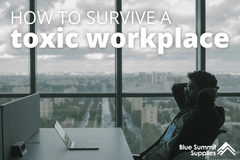Let’s talk about realistic optimism. Being realistic can have a healthy impact on a workplace, and when paired with optimism, it can be grounding, motivating, and inspiring all at once. In this post, we discuss why realistic optimism should replace toxic positivity in the workplace and how to effectively make the switch.
Negative, toxic people are easy to identify in a workplace, and the implications are clear. Negative people hinder productivity and motivation, and they bring all of the people surrounding them down too. But what about toxic positivity? Too much of a good thing, in this case, can truly be a bad thing.
The Negative Impact of Toxic Positivity in the Workplace
Toxic positivity is the ‘good vibes only’ mindset—a stubborn belief that no matter how bad your circumstances are or how disastrous or painful a situation is, people should just stay positive. Considering the fact that staying positive is a biological and spiritual impossibility, toxic positivity encourages people to bury their negative emotions in favor of a bright, bubbly, aggressively cheerful facade. For example, the character Joy in Pixar’s Inside Out.
Now, don’t get the impression we’re knocking positive thinking—it certainly has its time and place. Toxic positivity is when you ignore the facts of a situation or the painful emotions of another person and suggest the reason they’re unhappy is that they’re not working hard enough to be happy.

Toxic Positivity Phrases to Avoid:
- “Look on the bright side.”
- “Everything happens for a reason.”
- “It could have been worse.”
- “Stay positive.”
- “Happiness is a choice.”
Toxic positivity has serious negative effects on a workplace, as it causes team members to suppress concerns, emotions, and needs, both personal and professional. Toxic positivity workplace issues affect many businesses and teams. Ignoring bad business outcomes or adversity within a team won’t make it go away; it will cause the situation to become much worse until someone or something cracks under the pressure.
🎙Want to learn more? Check out this Brené Brown toxic positivity podcast, which digs into the dangers of toxic positivity.
What is Realistic Optimism?
Optimism is vital to our success and our ability to pursue our dreams. We have to believe we can accomplish something in order to give it a try. But there are two forms of optimism: realistic and unrealistic. Toxic positivity is akin to unrealistic optimism; it makes us believe that good things will happen to us simply because we believe they will, with no other effort required on our part.

Realistic optimism is optimism with a plan. Realistic optimists also believe good things will happen—but only through hard work and dedication. The realistic optimism definition is believing in your own ability to succeed while accepting that the road to success will be challenging.
Realistic optimism is the solution to toxic positivity at work. It enables transparent communication between business owners, managers, and teams, inspires informed and effective decision making, improves adaptability and solution-oriented problem solving, and boosts team morale.
How to Transition to Realistic Optimism
Set SMART Goals
SMART goals are the best type of goals in that they’re realistic. SMART is a decision making framework designed to help teams and organizations arrange and measure goals in a practical, clear, and comprehensive way.

SMART stands for Specific, Measurable, Achievable, Relevant, and Timely.
Specific
- A goal needs to be unambiguous and targeted for teams to be able to plan effectively. A goal must be more clearly defined than “increase profits.” Increase profits by how much and by what date? What’s the first actionable step the team can take to achieve that goal?
Measurable
- How do you know if you’re making progress or if you’re on the right track? In order to effectively manage your goal, progress needs to be something you can measure at regular intervals. What are the specific metrics that demonstrate the team is making headway?
Achievable
- Does the team agree the goal can be accomplished within the selected time frame, or is it so big that no one knows exactly where to start? For a team to be motivated to succeed, the goal must be grounded in reality and divided into practical, actionable steps.
Relevant
- Every goal should be tied to the long-term goals and values of the company. How will accomplishing this goal serve the interests and future hopes of the entire business.
Timely
- What’s the timeline for accomplishing the goal? A practical but ambitious time frame creates urgency and supports efficient decision making. Which task needs to be accomplished first? How do you prioritize the tasks and action items necessary to realize your goal?
Setting SMART goals allows teams to be hopeful for the future while maintaining realistic expectations with specific parameters around how the goal will be achieved.
Understand Your Circle of Control
While it’s nice to think we have complete autonomy over our lives and our careers, what we don’t control could fill a warehouse. There are innumerable things that are simply out of control. Understanding what we can and can't control helps us balance our emotions for a more realistically optimistic approach.

We can’t control the weather, traffic, or what someone else believes. We can control how we react to our circumstances by determining our own attitude and mindset.
If something is within our control, then it’s up to us to maintain or improve that aspect of our lives. If it’s out of our control, we need to work hard to move past it.
A few examples of what’s inside your circle of control:
- Your actions and reactions
- Your decisions
- The words you choose
- The food you eat
- The things you buy
A few examples of what’s outside your circle of control:
- What other people do
- What other people feel
- Other people’s choices
- The weather
- What’s on the news
📚Learn more in our article Circle of Control: Combating a Lack of Control at Work.
Know Your Own Personality
Whether you’re naturally pessimistic, optimistic, realistic, or some combination of the three, in the workplace, it’s important to balance these personal tendencies. In order to adjust to situations accordingly and work on personal areas of difficulty, we first need to understand our own personality and habitual way of thinking.
Personality assessments can help you better understand how you naturally react to change, stress, conflict, or the unknown. We’ve discussed the Enneagram personality assessment in great detail on the Blue Summit blog. We use it as a way to better understand ourselves and those we work with. If you haven’t already, check out our articles on Enneagram strengths and weaknesses and using Enneagrams to better understand coworkers.

Through the lens of the Enneagram, an 8wing7 or 7wing8 is a realistic optimist by nature. They are practical and action-oriented, but they also dream big and hope for the best. On the other hand, Enneagram 4s and 5s are often impractical and pessimistic. They are natural worriers prone to neuroticism and flights of fancy.
Our personal tendencies don’t need to define us, but in order to build a healthy, realistically optimistic mindset, it’s important to understand where you are starting from.
Practice Gratitude

Taking the time to reflect on all that we’re grateful for enhances optimistic thinking, allowing us to focus on all that’s positive in our lives, our circumstances, and the people around us.
Reframe Problems Into Opportunities

Practicing this adaptable, roll with the punches mindset can help us become more comfortable with trying new things, taking risks, and making mistakes, because no matter the outcome, we know that we’ll learn something from the experience in the end.
More from Blue Summit Supplies
💡 How to Make Office Friends and Get Along with Coworkers
💡 How to Handle Intimidation at Work
We’re passionate about workplace happiness and wellbeing. Follow our office supplies blog for the latest trends, team building strategies, product comparisons, and more.
If you have any questions or want to talk to someone about office supplies, send us an email or connect with us on Twitter, Facebook, or Instagram.
 For more informative articles about office supplies, subscribe to our email newsletter!
For more informative articles about office supplies, subscribe to our email newsletter!
Never fear, you won't begin receiving daily sales emails that belong in a spam folder. Instead, we promise a fun weekly roundup of our latest blog posts and great finds from across the web. And if you lose interest, it's always easy to unsubscribe with a single click.









